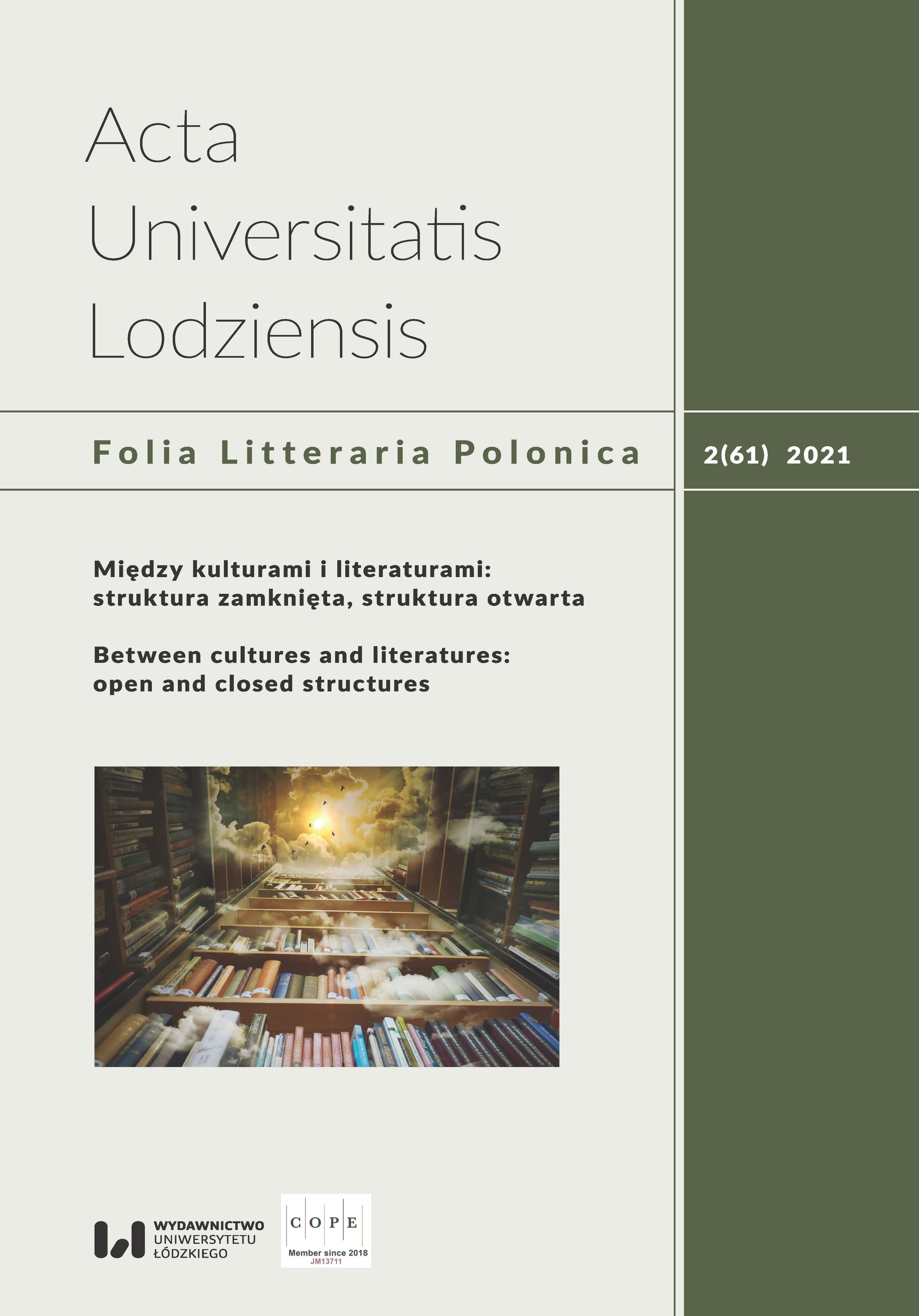Fairies in disguise. The reception of Madame d’Aulnoy’s fairy tales in Poland – Research reconnaissance
DOI:
https://doi.org/10.18778/1505-9057.61.03Keywords:
French literary fairy tale, fairy tale reception of in Poland, fairy tale and literature for children, adaptation of fairy tales, humour in fairy talesAbstract
This article focuses on the Polish reception of Marie-Catherine d’Aulnoy’s fairy tales from the 18th century until the present day. It discusses their translations, as well as adaptations published with the erroneous attribution to Charles Perrault and texts loosely inspired by the work of the French conteuse. The latter’s diversity is mirrored by the varied reception, encompassing both simplified texts for children, and a moralizing-and-fantasy long poem. Nevertheless, the rococo fairy tales by Madame d’Aulnoy, displaying the esthetic ideals of 17th-century salons and engaging in an ironic game with the genre’s didactic convention, do not fit the frame of the evergreen stereotype of the fairy tale as a simple and morally unambiguous genre, intended first and foremost for children. The transgressive nature of Madame d’Aulnoy’s fairy tales may be the cause for their incomplete interpretations, as well as their limited and selective reception in Poland.
Downloads
References
Abłażej Lech, Siedem bajek o królewnach, Wydawnictwo ELIPSA, Warszawa 1997.
Google Scholar
Aiken Joan Delano, Baśnie z całego świata, przekł. Barbara Grzegorzewska i in., Nowa Era, Warszawa 2006.
Google Scholar
b.a., Perrault: Bajki, przekł. Łukasz Jańczyk, Wydawnictwo FENI X, Wierzchy Parzeńskie 2012.
Google Scholar
Baumann Esther i in., Najpiękniejsze bajki z 4 stron świata. T. 1, przekł. Teresa Mikraszewska, Grafag, Warszawa 1997
Google Scholar
Borowy Wacław, Drużbacka i pani d’Aulnoy („Fabuła o Xiążęciu Adolfie”), „Pamiętnik Literacki” 1920, 17–18, nr 1, s. 17–37.
Google Scholar
Craveri Benedetta, Złoty wiek konwersacji [La civiltà della conversazione], przekł. Joanna Ugniewska i Krzysztof Żaboklicki, Oficyna Naukowa, Warszawa 2009.
Google Scholar
D’Aulnoy Marie-Catherine, Baśnie czarodziejskie pani d’Aulnoy, przekł. Robert Stiller, Wydawnictwo „Alfa”, Warszawa 1987.
Google Scholar
D’Aulnoy Marie-Catherine, Błękitny ptak i inne baśnie, przekł. Barbara Grzegorzewska, wstęp Grzegorz Leszczyński, Nasza Księgarnia, Warszawa 2007.
Google Scholar
D’Aulnoy Marie-Catherine, Contes des fées, suivis des Contes nouveaux ou Les Fées à la Mode, red. i oprac. Nadine Jasmin, wstęp Raymonde Robert, „Bibliothèque des Génies et des Fées” 1, Honoré Champion Éditeur, Paris 2004.
Google Scholar
[D’Aulnoy Marie-Catherine], Historya angielska politico-moralis, Hippolita Millorta z Duglas, z Julią corką hrabi z Warwiku, awantury przyiazni opisuiąca, z angielskiego ięzyka na francuzki, z francuzkiego na polski przetłumaczona dla zabawy życzliwym przyiaciołom przez J.P. Jozefa Jana Nepomucena Raczyńskiego, Poznań 1756.
Google Scholar
Deulin Charles, Les contes de ma mère l’Oye, avant Perrault, E. Dentu, Paris 1878.
Google Scholar
Drużbacka Elżbieta, Fabuła o Xiążęciu Adolfie, Dziedzicu Roxolanij, którego Czas przez lat trzysta szukaiąc, znaleść nie mógł; przypadkiem powracaiąc z Wyspy szczęśliwości od tegoż czasu złapany, śmierci prawu zadosyć uczynić musiał, które dla wszystkich naydłużey żiących ludzi postanowione, w: Poezje Elżbiety Drużbackiej, t. II , Lipsk 1837, s. 183–259.
Google Scholar
Feat Anne-Marie, Playing the Game of Frivolity: Seventeenth-Century „Conteuses” and the Transformation of Female Identity, „The Journal of the Midwest Modern Language Association” 2012, 45, nr 2, s. 217–242.
Google Scholar
DOI: https://doi.org/10.1353/mml.2012.0029
Guarnieri Rossana, Najpiękniejsze baśnie, najwięksi bajkopisarze. Perrault, przeł. Agnieszka Rylukowska, Wydawnictwo BGW, b.m. 1992.
Google Scholar
Hourcade Philippe, En relisant Mme d’Aulnoy conteuse, „Féeries” 2017, nr 14 http://journals.openedition.org/feeries/1043 [dostęp 8.09.2018].
Google Scholar
DOI: https://doi.org/10.4000/feeries.1043
Kaczyńska Barbara, W poszukiwaniu utraconych morałów. Tłumaczenie moralités w baśniach Charles’a Perraulta na przykładzie wybranych tekstów polskich, „Dzieciństwo. Literatura i Kultura” 2019, 1, nr 2, 12–35.
Google Scholar
DOI: https://doi.org/10.32798/dlk.167
Korneeva Tatiana, Rival Sisters and Vengeance Motifs in the „contes de fées” of d’Aulnoy, Lhéritier and Perrault, „MLN” 2012, 127, nr 4, s. 732–753.
Google Scholar
DOI: https://doi.org/10.1353/mln.2012.0112
Lhéritier de Villandon Marie-Jeanne i in., Contes, red. i oprac. Raymonde Robert, „Bibliothèque des Génies et des Fées” 2, Honoré Champion Éditeur, Paris 2005.
Google Scholar
Meer Jan van der, Literary Activities and Attitudes in the Stanislavian Age in Poland (1764–1795). A Social System?, Rodopi, Amsterdam–New York 2002.
Google Scholar
Monnier Magali, Translation as Generic Transposition: Minnie Wright Translates Marie-Catherine d’Aulnoy’s “La Chatte Blanche” [1698] for The Blue Fairy Book [1889], w: Collection Euryopa, t. 62, 2009, Langues européennes en dialogue, red. O. Knechciak, s. 51–65.
Google Scholar
Perrault Charles i in., Contes merveilleux, red. i oprac. Tony Gheeraert, „Bibliothèque des Génies et des Fées” 4, Honoré Champion Éditeur, Paris 2005.
Google Scholar
Perrault Charles i in., Gabinet wróżek. Antologia basnie francuskiej XVII–XVIII wieku, red. i oprac. Ryszard Waksmund, Wacław Bagiński, Warszawa 1998.
Google Scholar
Rittel Teodozja, „Miłość nieprzykładna” Elżbiety Drużbackiej. Rozwinięcie intertekstowe motywu orła i słońca (konteksty interpretacyjne), „Annales Universitatis Paedagogicae Cracoviensis. Studia Historicolitteraria” 2004, nr 4, s. 5–19.
Google Scholar
Robert Raymonde, Le Conte de fées littéraire en France de la fin du XVIIe à la fin du XVIIIe siècle, Presses Universitaires, Nancy 1981.
Google Scholar
Schacker Judith, Unruly Tales: Ideology, Anxiety, and the Regulation of Genre, „The Journal of American Folklore” 2007, (120), nr 4, s. 381–400.
Google Scholar
DOI: https://doi.org/10.1353/jaf.2007.0066
Stiller Robert, Za kulisami przekładu, „Sztuka dla dziecka” 1987, nr 4, s. 3–6.
Google Scholar
Stiller Robert, Posłowie tłumacza, w: J. Huizinga, Jesień średniowiecza, przeł. Robert Stiller, Vis-à-vis Etiuda, Kraków 2018, s. 377–390.
Google Scholar
Sztuczyńska Jolanta, Bajki Charles’a Perraulta, Nasza Księgarnia, Warszawa 2015.
Google Scholar
tż [krypt.], Baśnie czarodziejskie pani d’Aulnoy [recenzja], „Sztuka dla dziecka” 1988, nr 1, s. 48.
Google Scholar
Viala Alain, D’une politique des formes: la galanterie, „XVII e siècle” 1994, nr 182, s. 143–151.
Google Scholar
Wasilewska Anna, Fantastyka baśniowa a dziecko – wychowanie czy manipulacja?, Wydawnictwo UG, Gdańsk 2012.
Google Scholar
[Wright Minnie i in.], Baśnie i powiastki dla pilnych dzieci, przeł. Janina Colonna-Walewska, Warszawa 1929.
Google Scholar
Zarawska Patrycja, 365 opowieści na dobranoc. Baśnie Perraulta, Firma Księgarska Olesiejuk, b.m. 2015.
Google Scholar
Downloads
Published
How to Cite
Issue
Section
License

This work is licensed under a Creative Commons Attribution-NonCommercial-NoDerivatives 4.0 International License.











